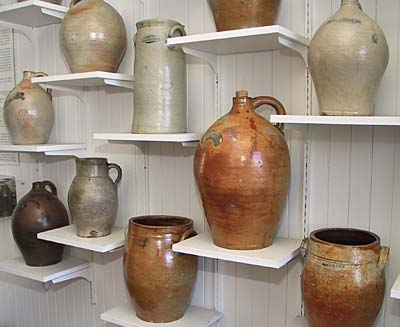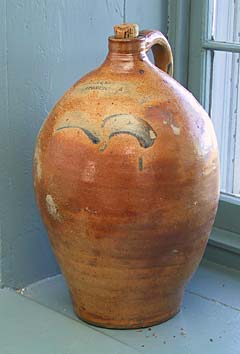STONINGTON POTTERY

The stoneware displayed at the Stonington Historical Society's Old Lighthouse Museum was all made in Stonington between 1780 and 1834. This is remarkable because stoneware vessels must be made from a specific grey-white clay found, not in New England, but in areas of New Jersey and New York, from where it was imported.
The soft wet clay was hand formed, or thrown, on a potter's wheel, then set aside to dry. It was commonly washed with rich, brown "Albany slip" and then placed into the kiln to be fired. To harden the stoneware and give it its characteristic waterproof glaze, a shovelful of common salt was hurled into the blazing furnace.
Usually the only color decoration used on Stonington pottery was a splash of cobalt blue around the handles or through the name, painted on before the piece was fired. Other color variations, such as the deep oranges seen in some of the museum examples, were accidental, owing to the impurity of the clay and the unevenness of the kiln temperature. Blue flowers and other motifs seen commonly elsewhere were rarely used in Stonington and examples of incised designs or figures, such as those seen in the museum's collection, are quite unusual.
The large jugs seen here are typical of the pottery produced in Stonington, but smaller pieces, such as pitchers and inkwells, were also manufactured.
Three Phases in Stonington Pottery Production

1. In 1778, Adam States II married Esther Noyes of Stonington and settled near Hinkley Hill in what is now Pawcatuck. In the years between then and his death in 1826, he built and operated a pottery works there - most likely with the help of his uncle, Peter States, his cousin, William States, and his sons, Adam III, Ichabod and Gilbert. The few surviving pieces of this period are marked "A. STATES" or "A STATES & CO".
2. In 1811, William States established a new pottery works off "Shinbone Alley", which is at the end of what is now Wall Street in Stonington Borough. With the help of his cousin, Adam States III, he produced a wide variety of stoneware until his death in 1823. These pieces are marked "W. STATES".
3. Upon William's death, the pottery business was taken over by Ichabod States and Joshua Swan. Financial problems ended their pottery production in 1834 but by then the mark "SWAN & STATES, STONINGTON" was familiar all along the New England coast
For a bibliography of Early American Pottery, the Smithsonian Insititute offers Ceramics of the United States at
www.si.edu/resource/faq/nmah/usceram.htm
